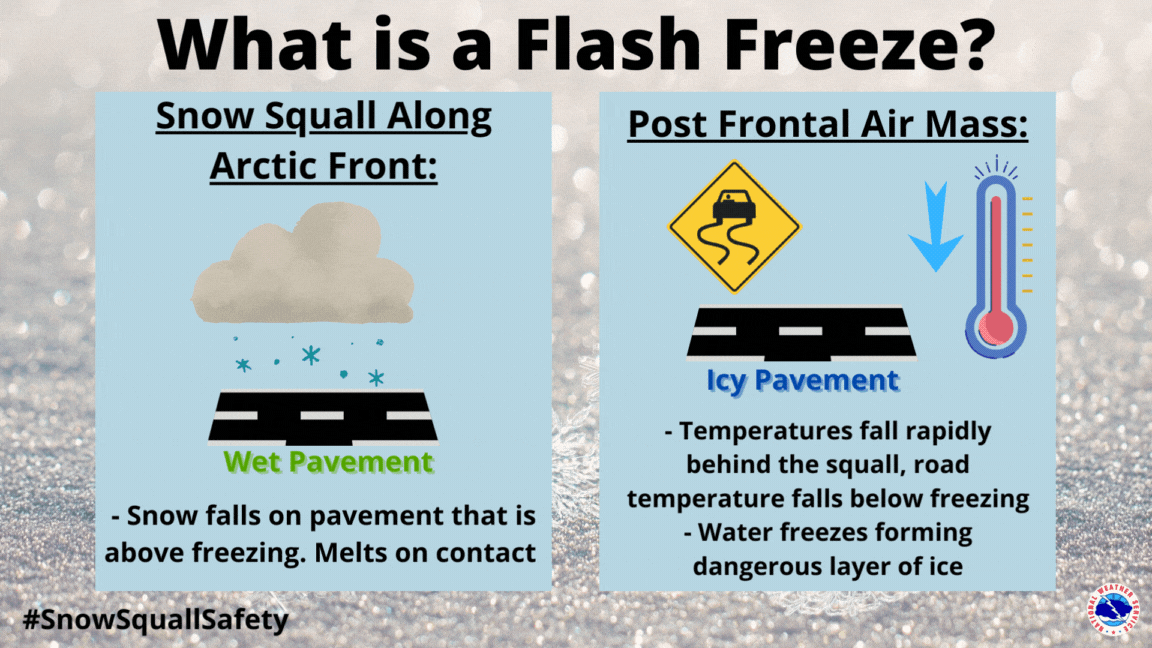
Showers, along with a few strong to severe thunderstorms, are expected from the Great Lakes, New England and southward into the Ohio and Tennessee Valleys. In the wake of this system, a stronger storm is expected to track from the Pacific Northwest, Plains and through the Eastern U.S. this weekend. Strong winds, showers and a larger drop in temperatures are expected this weekend into Monday. Read More >
What is a Snow Squall?

Snow squalls are one of the most dangerous winter weather phenomena. Check out these tabs to know what they are, how to be safe, and where to get the necessary information to always stay weather aware!

Snow squalls are often associated with strong cold fronts and are a key winter weather hazards. Sudden whiteout conditions, gusty winds, and falling temperatures produce icy roads in just a few minutes. There is no safe place on a highway during a snow squall.

Snow flurries and snow showers are common in eastern Washington and northern Idaho, but snow squalls are an especially dangerous weather hazard. Check out this graphic to see what makes snow squalls unique - they're not just a typical snow shower.

A common hazard associated with snow squalls is a "flash freeze". Rapidly-falling temperatures along with melting snow on high-traffic roads can cause untreated highways to turn into a sheet of ice.
Heavy snow bursts + flash freezes = extreme impacts.

A snow squall is similar to a summertime thunderstorm with heavy precipitation in a short amount of time and strong winds. Thunderstorms can produce flooding from heavy rain, but the icy roads that result from snow squalls are often much more dangerous.

Snow squalls often catch drivers by surprise because the sky goes from clear blue to heavy snow in a matter of minutes. Learn how to identify snow squalls in the distance and exit before you drive through one: it could save your life!

For a flash freeze to occur, air temperatures must be at or below 32°F. As such, snow squalls can happen anytime between November and March.
Remember this image when snow squalls are in the forecast. There is no safe place on a highway during a snow squall.
A Snow Squall Warning is issued by the National Weather Service when hazardous travel is expected. If you are within the bounds of a Snow Squall Warning, expect reduced visibility, icy roadways, and rapidly-changing conditions. Visit weather.gov/safety/winter-snow-squall to learn more.


In the past, all Snow Squall Warnings have triggered a Wireless Emergency Alert (WEA). This year, WEA will only be activated for SIGNIFICANT snow squalls. If your phone goes off, take the Warning seriously and delay travel or exit as soon as possible!

When a snow squall hits, strong winds, a sudden drop in temperatures, and heavy snow bursts create very dangerous and life threatening travel. Simply put, there is no safe place on a highway during a snow squall.

When a Snow Squall Warning is issued for your location, avoid or delay motor travel until the squall passes. Even if it “looks” safe, visibility can drop within minutes! There is no safe place on a highway during a snow squall.

When a snow squall hits, visibility can drop to almost nothing in an instant. There is no safe place on a highway during a snow squall, but what if you get stuck on the road? Reduce your speed, turn on your headlights, and don’t slam on your brakes!

Multi-car pileups are what make snow squalls deadly. What should you do if you’re in a pileup? Whatever you do, DO NOT stand outside your vehicle on or near the roadway. Follow the guidance below.
